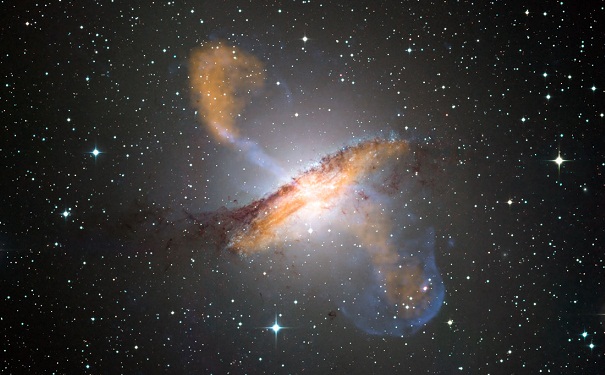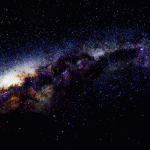
This composite of microwave (orange), visible and X-ray (blue) data reveals the jets and radio-emitting lobes emanating from Centaurus A's central black hole. Credit: ESO/WFI (visible); MPIfR/ESO/APEX/A.Weiss et al. (microwave); NASA/CXC/CfA/R.Kraft et al. (X-ray)
The best-ever snapshot of galactic jets has been taken using multiple telescopes.
An international team has produced a highly detailed image of black hole jets in a nearby galaxy. The image, produced using radio telescopes located throughout the Southern Hemisphere, shows the particle jets erupting from a super massive black hole with a mass 55 million times that of the sun.
Cornelia Mueller, a doctoral student at the University of Erlangen-Nuremberg in Germany, and her team focused on the nearby galaxy Centaurus A (Cen A), approximately 12 million light years away in the constellation Centaurus. Using an array of nine telescopes, the researchers from the Tracking Active Galactic Nuclei with Austral Milliarcsecond Interferometry (TANAMI) project were able to zoom in and take a detailed image of the galaxy.
Roopesh Ojha, NASA’s Goddard Space Flight Center, explained in the press release “Advanced computer techniques allow us to combine data from the individual telescopes to yield images with the sharpness of a single giant telescope, one nearly as large as Earth itself.”
Cen A is located between two giant radio-emitting lobes, causing it to appear as one of the brightest objects in the sky (when seen via radio waves). Both of these lobes are nearly a million light years in length and are fed by matter streaming from the particle jets near the super massive black hole at the centre of the galaxy.
Mueller said in the press release “These jets arise as infalling matter approaches the black hole, but we don’t yet know the details of how they form and maintain themselves.”
Cen A also has an enormous energy output, caused by gas falling towards the black hole. Matthias Kadler, University of Wuerzburg in Germany, said in the press release “This radiation is billions of times more energetic than the radio waves we detect, and exactly where it originates remains a mystery.”
“With TANAMI, we hope to probe the galaxy’s innermost depths to find out.”






